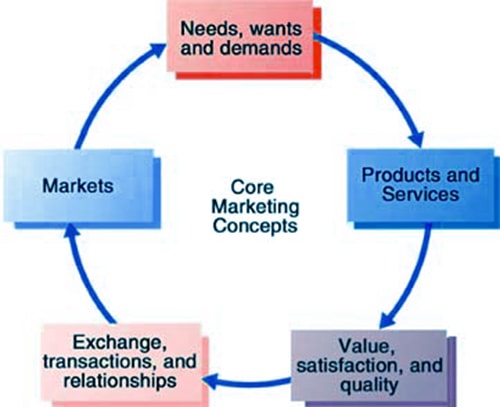A core concept is one which has a very clear-cut, definite, widely acceptable, relevant, and verifiable to understand the very process of marketing that directs the flow of goods and services from producers to consumers.
These core concepts are:

- Needs, Wants, and demands
Need: It is state of deprivation of sonic basic satisfaction. eg.- food, clothing, safety, shelter.
Want: Desire for specific satisfier need. eg. Indians need food – wants paneer tikka/ tandoori chicken. Americans need food- wants hamburger/ French fries.
Demand: Want for a specific product backed up by ability and willingness to buy. eg – Need – transportation.want – Car (say, Mercedes) but able to buy only Maruti. Therefore, demand is for Maruti.
Marketers cannot create needs. Needs preexists. Marketers can influence wants. This is done in combination with societal influencers.
Demand influenced by making the product:
- APPROPRIATE
- ATTRACTIVE
- APPROACHABLE/ AFFORDAI3LE
- AVAILABLE EASILY
To target consumers (4 P’s) – Product/ Promotion/ Price/ Place
- Marketing Offers
Product: Anything that can be offered to the market for attention, acquisition, use or consumption that might satisfy a want or need. It includes physical objects, services, persons, places, organizations, and ideas.
The concept of the product is not limited to physical objects- anything capable of satisfying a need can be called a product. In addition to tangible goods, products include services.
Example: Mobile phone, Laptop, banking, airline, home repair services, etc.
Service: Any activity or benefit that one party can offer to another that is essentially intangible and does not result in the ownership or anything.
- Value, Satisfaction, and Quality
Customer Value: The difference between the values the customer gains from owning and using a product and the costs of obtaining the product.
Customer Satisfaction: The extent to which a product’s perceived performance matches a buyer’s expectations. A customer might be dissatisfied or satisfied.
- If the product’s performance falls short of expectations, the buyer is dissatisfied.
- if the performance matches or exceeds expectations, the buyer is satisfied or delighted.
Customer satisfaction depends on a product’s perceived performance in delivering value relative to a buyer’s expectation. Smart companies aim to delight customers by promising only what they can deliver, then delivering more than they promise.
Quality: Programs designed to constantly improve the quality of products, services, and Marketing processes.
- Exchange, Transactions, and Relationships
Exchange: The act of obtaining the desired object from someone by offering something in return.
Example: Hungry people could find food by hunting, fishing, or gathering fruit, They could beg for food or take food from someone else. Or they could offer money, another good, or a service in return for food.
Transaction: A trade between two parties that involves at least two things of value, agreed-upon conditions, a time of the agreement, and a place of agreement.
Example: One party gives X to another party and gets Y in return. Salvy pays S600 to buy a television.
Relationship marketing: The process of creating, maintaining, and enhancing strong, value-laden relationships with customers and other stakeholders.
- Market
The set of all actual and potential buyers of a product or service.The size of the market depends on the number of people who exhibit the need, have resources to engage in exchange and are willing to offer these resources in exchange for what they want.











